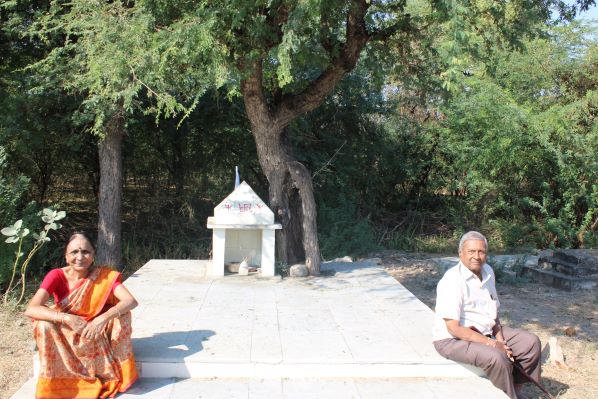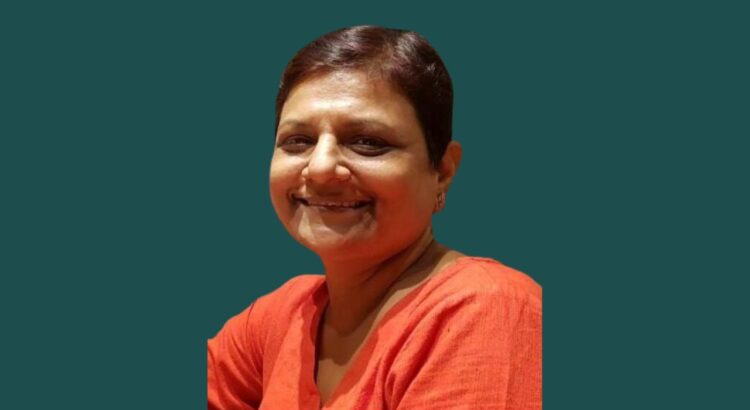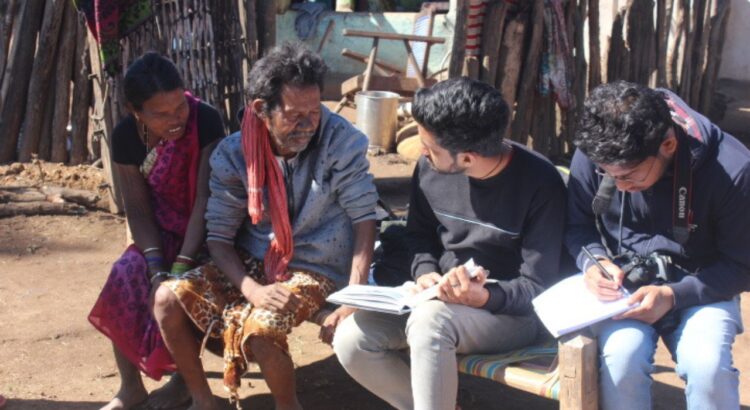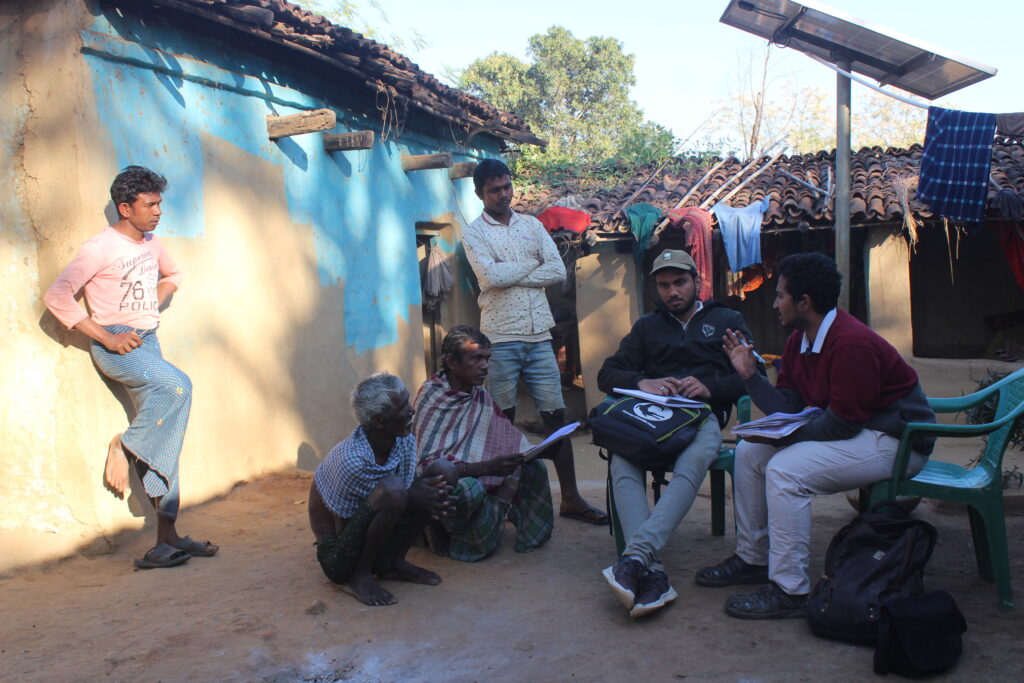Naivedyapūjā (नैवेद्यपूजा) refers to the “Pūjā of sweetmeats” and represents one of the eight-fold Pūjā, according to Hemacandra’s 11th century Triṣaṣṭiśalākāpuruṣacaritra: an ancient Sanskrit epic poem narrating the history and legends of sixty-three illustrious persons in Jainism. Dr Kamini Vrajlal Gogri ‘s research “Exploring Sacred spaces between food cultivation and naivedya and prasad with respect to kuldevi , Jakkha, Snake and Ganesh worship within the Jain community of Kutch,” shows many new changes that are happening to the traditional offerings made during Jain worship due to modernity and migration.
How did you get interested in Jain studies? How does your work in Jaina Prosopography bring together manuscript, epigraphic catalogues and biographical literature?
By birth I am a Jain, and my mother instilled the samaskaras since a very young age. As I grew, my passion for history and philosophy became serious and I ended up taking up research in Jainology.
The Prosopography project I am working on researches lineages on Jain ascetics. This research is done based on original sources as you have mentioned. So the SOAS (School of Oriental and African Studies, UK) project is an online project where in the data is researched on the basis of original catalogues, colophons etc and uploaded online.

In your INDICA fellowship you researched the Kutchi Jain community. What are the different localised Jain communities and how do their practices and observances differ? What are the main socio-economic conditions causing this difference?
My research was based on the Jain community from Kutch. The Kutchi Jains are now settled in Mumbai and abroad. The practices while similar, the prasad offered differs in some manner. Mainly it is financial and new age changes which have been adopted due to migrations which cause the differences.
Excerpt from Report: The choice of the subject was made to bring out the lesser-known area of agro biodiversity interlinked with the sacred spaces shared within the Kutchi Jain Community. Kutch, today known for its Rannutsav or the desert festival and handicrafts industry, was once upon a time a rich fertile region. It was a part of the Saraswati Sindhu civilization having far reaching trade till Africa. When the fertile land turned dry, the nature of agriculture changed. This study made me rethink the methods of how and why the naivedya and prasad evolved. It raised certain fundamental issues- firstly Kutchi Jains once upon a time were Rajputs, non vegetarians, and due to unfavourable conditions migrated from Osiyaji in Rajasthan and settled in Kutch. Their offerings turned from meat to wheat and rice. How and when this happened was one of my areas of research. Secondly, the land has its own fertile value. The land, the farmers, the tattvas and people shared space with each other. How these connections co-existed with the sacred spaces was interesting. Thirdly, the migration to Mumbai from Kutch led to drastic changes; the relation with the land become distant for those who were born in Mumbai than for those who were born in Kutch and migrated to Mumbai for a living. The practice of naivedya and prasad continues till date but with drastic changes. Food grains now purchased from the market where once they were directly got from the agricultural land. More than the land, the offerings became important. While sacred rituals are important it is important to ask how worship is connected to life directly, as opposed to via the media of naivedya or prasadam, which have their own sanctity. The rituals of performing the acts of agriculture bear a more important and internalized affair in human and environment life and the divine elements are internal to this system.

What are your thoughts on the food culture of Jain communities? How did you acquire this knowledge?
Studying traditional food practices in the Kutch region, my father and I spent days driving through the district with Nihalbhai, our friend and guide, visiting families, farms and markets. We visited the homes of his friends and acquaintances; all of whom invited us to home-cooked meals, offering insight into the culinary practices of the region.
Parmaben, 82, from Kukma village, remembers life in Kutch from her youth: preparing food took up large parts of their days, and was often a challenging task. People had to work hard and smart when it came to food resources, in order to feed their families through the dry seasons. Meals were fairly simple, and made the best use of the limited grains and vegetables available. The luxury of perennial irrigation was still several decades away, and farming was restricted to the rainy season, yielding an annual harvest just enough for one family. This kind of farming — dependant solely on unpredictable rains — was called sukki kheti (dry farming), and practiced by every family that owned even a small patch of land.
Whatever food the family grew during the rains would then be preserved, to be consumed through the rest of the year. Vegetables would be dried to make sukhawani — either sun-dried or shade-dried. The latter took longer, but was preferred, as it better preserved flavour and nutrition. This store of vegetables would be portioned out judiciously on special occasions, until the next harvest rolled around.
Traditional knowledge of locally grown food was ubiquitous among the older generation: the consumption of bajra (pearl millet) and jowar (sorghum millet), the two staple grains of the region, were guided by the inherent understanding of nutrition. Bajra, a heat-generating food, was traditionally eaten in the winter, and jowar, a food that cooled the body, was consumed in the summer.
Knowledge about wild plants too, was commonplace; deemed necessary in order to forage for edible plants in the desert or grasslands to supplement the domestic food crops from sukki kheti. For example, jungli karela, delicious wild bitter gourd, is often collected for dinner, while jungli ringna, wild eggplant, is considered poisonous. On the highway, Nihalbhai stopped the car to point out both plants, growing right next to each other, their creepers almost intertwined. He could tell them apart without a second glance. But this kind of knowledge is now rare; lost and forgotten within the younger generations.
Another interesting plant is the prickly baranth grass. With thorns on its stem, leaves, and on its burrs (inside which its seeds are stored), the grass is actually a source of wild grain. Villagers would often scout the grasslands to find this grass among several varieties of similar-looking wild grass. Then, a piece of cloth is gently brushed over the grass to collect the thorny burrs, which are carried back to the village.
The burr is pounded to free the tiny black seeds within. These seeds are then used like most other grains — ground to a flour and made into flatbread, or cooked with split mung beans to make khichdi. Wild grasses produce just a fraction of the seeds that domesticated grain crops do, so this painstaking process of collection is repeated for days before sufficient stores are built up. Parmaben tells me with disappointment that barely anyone knows the taste of baranth anymore, and nobody wants to go to such lengths to collect such little grain.
As for locally grown vegetables, they are limited in variety: garlic, chillies and onions are the mainstay. Arjunbhai Vankar, a weaver in the central Kutchi town of Bhujodi and my host one evening, explains that they are important in a Kutchi meal. “Traditionally, with no curries to accompany the jowar or bajra flatbread, these vegetables not only added flavour, but also activate the saliva and digestive juices.” After this, fiery tongues are soothed with gol (jaggery) and chhaas (buttermilk).

What is the connect with prasad and the Gods. Is there some understanding as to why certain foods were offered to deities by the Jain community?
Kheer, Payasa, Payasam or Phirni is a type of pudding from the Indian subcontinent, made by boiling milk, sugar, and rice, although rice may be substitute with one of the following: bulgar wheat, millet, tapioca, vermicelli, or sweet corn. It is typically flavored with desiccated coconut, cardamom, raisins, saffron, cashews, pistachios, almonds, or other dry fruits and nuts. It is typically served during a meal or as a dessert
The word "kheer" is derived from the Sanskrit word for milk, Ksheer (क्षीर). Ksheer is also the archaic name for sweet rice pudding. Kheer was a part of the ancient Indian diet and is mentioned in the Ayurveda. According to the food historian K. T. Achaya, kheer or payas, as it is known in southern India, was a popular dish in ancient India, first mentioned in ancient Indian literature. It was a mixture of rice, milk and sugar, a formula that has endured for over two thousand years. Payas was also a staple Hindu temple food, in particular, it was associated with Lord Shiva and served as Prasāda to his devotees. Khir in KVO Community is offered to Jakkhas.
Lapsi is believed to be the most auspicious food for Mataji, or mother goddess. Made of wheat, it is sweet to taste. Variants of lapsi are offered to other Matajis.
The lapsi seems to be chosen by Goddesses as their food as it is very easy to prepare, good to taste, filling to have and the ingredients are on easy available. In olden times the villagers made lapsi for any household celebrations. Wheat used for daily bread, jaggery for curries and desi butter (ghee) with some oil is all you need to make it.
Can concepts like paganism and polytheism be applied to Jain traditions, which are very complex and varied?
Polytheism yes. In spite of being Sramana in nature, focusing only on Moksa, the variety of gods and goddesses address the issues of common people helping to navigate the worldly ocean. The temple worshippers, ascetics also invoke these gods and goddesses to help run the samgha. Apart from these, cultural and geographically located divine beings are also worshipped by Jains, such as Kuladevis, Jakkas etc.
Excerpt from Report: The Kutchi Visa Oswal (Jains) owes gratitude to the Kul devi, who takes care of them. Every gotra has their respective Kul devi. Along with their respective devis, few gotras worship Jakkhas. Also included are Khetarpal (in snake form) and Ganesh too. Kul devis have their respective animals on whom their ride. Lacchal rides on a sheep, Mamla on camel etc. The Kula devi worship inherits features from Shakti worship.
Maa Jagat Bhawani Shri Sachchiyay Mataji also called Shri Osiya Mataji is the Kuladevi of Oswals. A large temple of Chamunda Mata was built in Upkeshpur, presently known as Osiya. The temple was known for chamatkars and attracted many worshippers. During Navratri, buffaloes were butchered and people gave offerings of buffalo flesh to please Chamunda Mata. Jain Acharya Shri Ratna Prabh Suri stopped this practice of animal killing. Because of this the goddess became angry and created pain in the eyes of the Acharya. He was not swayed and Chamunda Mata became ashamed and asked forgiveness from the Acharya.
As Head of Research at EIKAM, how do you enable its vision of making ancient knowledge and wisdom relevant today. How can living embodied faith be studied centuries after it was started, changing, and adapting according to the times.
To cater to the young minds, one has to speak in their own language. In the changing nature of festivals, or rituals, the younger generations like to enjoy in their own way. They want to understand how faith and reason go hand in hand. Making more visuals which are attractive. Use technology to show how relevant ancient wisdom is. In movies like Matrix, Avengers, Avatar, Last Jedi, Rama Setu etc, metaphysics meets wisdom of ancient world.
Since I am involved in inter faith dialogues with few institutions, I do take the opportunity to talk about the openness of non-Abrahamic faiths and about truth being non-one-sided.
Video Excerpt of the Interview



 Documentation from Vaidya
Documentation from Vaidya Cherchera Festival
Cherchera Festival